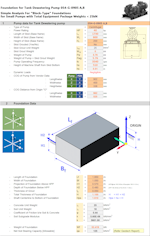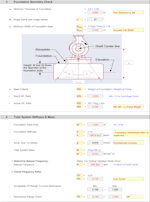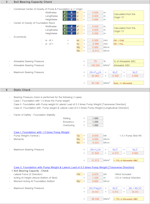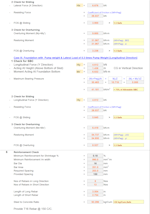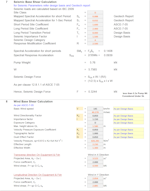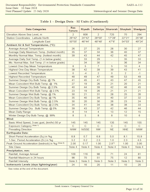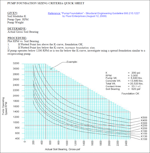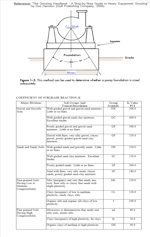Pump Foundation Design - Block Type For Multiple Pumps
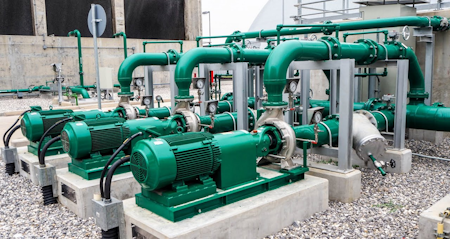
Description
This is Pump Foundation Design Tool to design multiple Block Type foundations for number of Pumps In a Project.
For a simple analysis of 'Block-Type' foundations for small dewatering pumps with a total equipment package weight of less than 25 kN, you can follow these basic steps:
-
Determine Foundation Dimensions:
- Calculate the foundation dimensions based on the equipment package weight and the specific layout requirements. For small pumps, a square or rectangular foundation is typically suitable.
-
Soil Investigation:
- Perform a soil investigation at the site where the pump will be installed. Gather information on soil bearing capacity, soil type, and any other geotechnical data that may impact the foundation design.
-
Load Calculation:
- Calculate the total load applied by the dewatering pump and its associated equipment to the foundation. This includes the weight of the pump, motor, piping, and any other accessories.
-
Factor in Dynamic Loads:
- Consider dynamic loads such as vibration and operational forces that the pump may generate. These loads can vary based on the pump's RPM and application.
-
Check Local Codes and Standards:
- Review local building codes and industry standards to ensure that your design complies with safety and regulatory requirements. This includes any specific guidelines for pump foundations.
-
Design Foundation:
- Use standard structural engineering principles to design the foundation. Ensure it is adequately sized to distribute the load over the soil without exceeding its bearing capacity.
-
Material Selection:
- Select appropriate materials for the foundation. Typically, reinforced concrete is a common choice for small pump foundations.
-
Reinforcement:
- Determine the required reinforcement, such as rebar, to provide the necessary strength and stability.
-
Foundation Thickness:
- The thickness of the foundation should be adequate to support the load and prevent cracking or settlement.
-
Detailing:
- Create detailed foundation drawings, including cross-sections and plan views. Ensure that the foundation design is clear and can be easily implemented by contractors.
-
Construction:
- Supervise the construction process to ensure that the foundation is built according to the design specifications.
-
Quality Control:
- Implement quality control measures to confirm that the materials and construction meet the required standards.
-
Load Testing (if necessary):
- Depending on site conditions and regulations, load testing may be required to ensure the foundation's stability and safety.
-
Documentation:
- Maintain detailed records of the foundation design, calculations, and construction process for future reference.
-
Inspection and Approval:
- Have the foundation inspected by relevant authorities or inspectors to ensure it meets all safety and regulatory requirements. Obtain necessary approvals.
Keep in mind that while this is a simplified guide for small pump foundations, the specific design and analysis may vary depending on site-specific conditions, local codes, and pump specifications. It's advisable to consult with a structural engineer or a geotechnical engineer to ensure the foundation is designed and constructed safely and in compliance with all relevant standards.
The information you provided outlines the various parameters and checks involved in the design and analysis of a foundation for a dewatering pump. Here is a breakdown of the key components and considerations:
-
Pump Data:
- Type of Pump
- Power Rating
- Length of Skid (Base frame)
- Width of Skid (Base frame)
- Height of Skid (Base frame)
- Skid Grouted (Yes/No)
- Skid Grout Unit Weight
- Skid Grout Weight
- Weight of Pump
- Weight of Pump + Skid Grout Weight
- Pump Operating Frequency
- Height of Machine Shaft from Skid Bottom
-
Dynamic Loads:
- COG of Pump from Vendor Data
- COG Distance from Origin 'O'
-
Foundation Data:
- Length of Foundation
- Width of Foundation
- Projection of Foundation Above HPP
- Depth of Foundation Below HPP
- Thickness of Grout
- Total Thickness of Foundation
- Shaft Centerline to Bottom of Foundation
- Concrete Unit Weight
- Soil Unit Weight
- Coefficient of Friction between Soil & Concrete
- Soil Subgrade Modulus
-
Mass Criteria:
- Required Wt. Ratio
- Actual Wt. Ratio
- Total System Stiffness & Mass:
- Foundation Base Area
- Foundation Stiffness
- Accel. Due To Gravity
- Total System Mass
- Determine Natural Frequency
- Check Frequency Ratio
- Acceptable FR Range To Avoid Resonance
- Resonance Range Check
-
Soil Bearing Capacity Check:
- Combined Center of Gravity of Pump & Foundation w.r.t Origin
- Center of Gravity of Foundation Block
- Eccentricity
- Allowable Bearing Pressure
- Maximum Bearing Pressure
-
Static Check:
- Bearing Pressure check is performed for the following 3 cases:
- Case I. Foundation with 1.5 times the Pump weight
- Pump Weight (Vertical )
- Moments
- Maximum Bearing Pressure
- Case II. Foundation with Pump Weight & Lateral Load of 0.3 times Pump Weight [Transverse Direction]
- Soil Bearing Capacity - Check
- Lateral Force (X Direction)
- Acting At Height (Above Bottom of Skid)
- Moment Acting At Foundation Bottom
- Maximum Bearing Pressure
- Check for Sliding
- Lateral Force (X Direction)
- Resisting Force
- FOS @ Sliding
- Check for Overturning
- Overturing Moment (My+My')
- Restoring Moment
- FOS @ Overturing
- Case III. Foundation with Pump weight & Lateral Load of 0.3 times Pump Weight [Longitudinal Direction]
- Check for SBC
- Longitudinal Force (Y Direction)
- Acting At Height (Above Bottom of Skid)
- Moment Acting At Foundation Bottom
- Maximum Bearing Pressure
- Check for Sliding
- Longitudinal Force (Y Direction)
- Resisting Force
- FOS @ Sliding
- Check for Overturning
- Overturing Moment (Mx+Mx')
- Restoring Moment
- FOS @ Overturing
- Case I. Foundation with 1.5 times the Pump weight
- Bearing Pressure check is performed for the following 3 cases:
-
Reinforcement Check:
- Minimum Reinforcement for Shrinkage %
- Minimum Reinforcement /m width
- Bar Dia
- Bar Area
- Required Spacing
- Provided Spacing
- Nos of Rebars in Long Direction
- Nos of Rebars in Short Direction
- Length of Long Rebar
- Length of Short Rebar
- Steel to Concrete Ratio
- Provide T16 Rebar @ 150 C/C.
-
Seismic Base Shear Calculation:
- Site Class
- Mapped Spectral Acceleration for short Period
- Mapped Spectral Acceleration for 1-Sec Period
- Short Period Site Coefficient
- Long Period Site Coefficient
- Long Period Transition Period
- Seismic Importance Factor
- Seismic Design Category
- Response Modification Coefficient
- Spectral Acceleration for short periods
- Spectral Response Acceleration
- Pump Weight
- Seismic Design Force
-
Wind Base Shear Calculation:
- Basic Wind speed
- Wind Directionality Factor
- Importance factor
- Exposure Category
- Max. height above GL
- Velocity Pressure Exposure Coefficient
- Topographic factor
- Gust Effect Factor
- Velocity Pressure, qz=0.613 x Kz Kzt Kd V2 I
- Effective Length
- Effective Width
- Transverse direction On Equipment & Fdn
- Longitudinal Direction On Equipment & Fdn
This extensive list of parameters and checks provides a comprehensive framework for the design and analysis of a foundation for a dewatering pump. It ensures that all relevant factors, including dynamic loads, seismic and wind forces, soil characteristics, and structural integrity, are considered in the design process. Engineers and designers can use this information to perform a thorough and accurate foundation design for the specific pump and site conditions.
Calculation Preview
Full download access to any calculation is available to users with a paid or awarded subscription (XLC Pro).
Subscriptions are free to contributors to the site, alternatively they can be purchased.
Click here for information on subscriptions.

